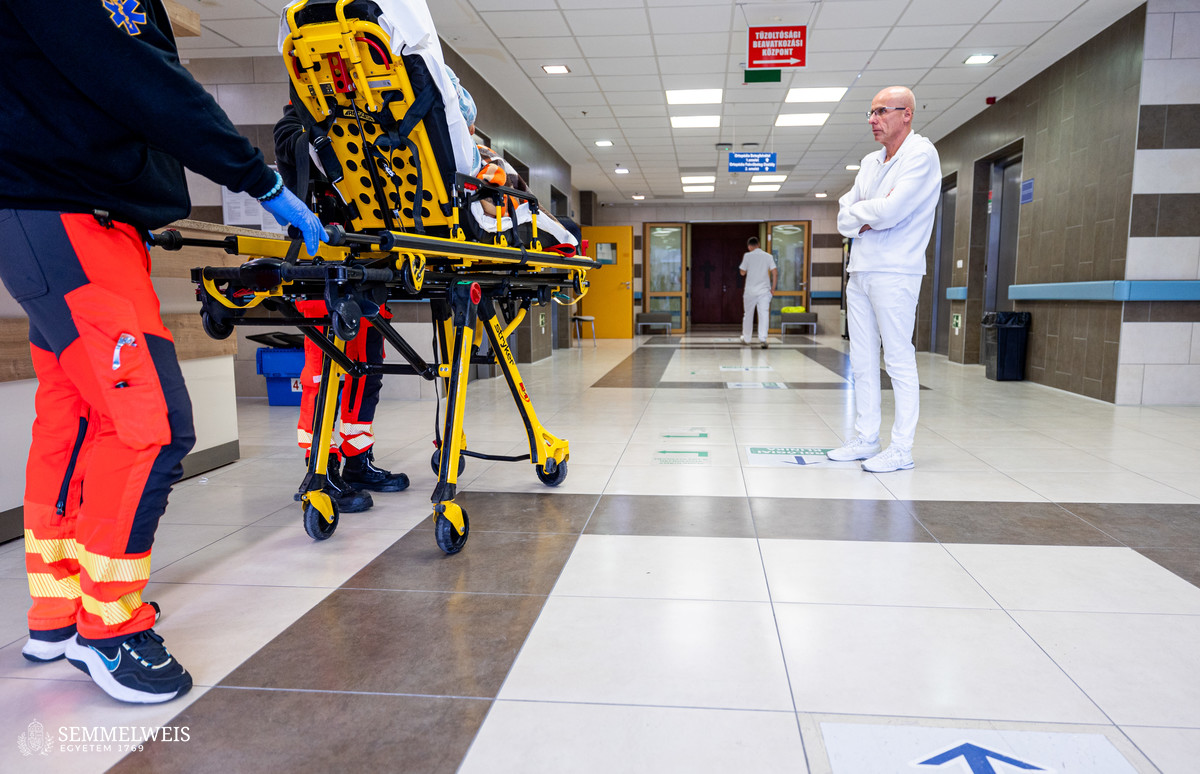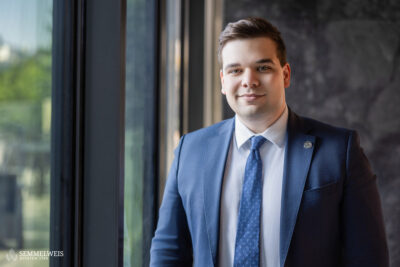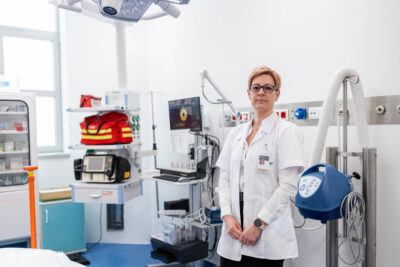According to the agreement between Semmelweis University, the National Directorate General for Hospitals, and the Central Hospital of Southern Pest, the Gusztáv Merényi Hospital of the Central Hospital of Southern Pest – Institute of Hematology and Infectious Diseases became the property of Semmelweis University on 1 November, along with the relevant regional care obligations. As a result, traumatology care has been moved from the Gyáli út address to the Semmelweis University Central Patient Care Building, close to the co-specialties (e.g. intensive care, surgery, imaging) with which close cooperation is required. With the change, the university’s portfolio has been expanded to include trauma care and a training site. The newly established Traumatology Clinic and the Department of Traumatology at Semmelweis University is headed by Dr. Tamás Bodzay, a traumatologist and orthopaedic surgeon, former director of the Dr. Manninger Jenő Traumatology Center in Budapest.
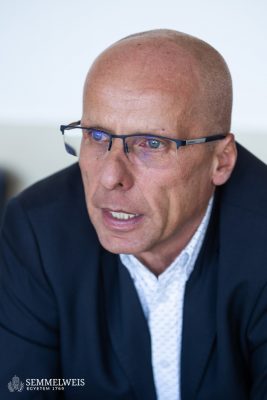 The clinic director pointed out that with the integration, the 564,000-person South Pest and South East Pest care area of the Merényi site was also transferred to the university. The Merényi hospital had 107 beds and 8 intensive care beds, the same structure is taken over by the university. The former Merényi traumatology department had nearly 30 specialists, orthopaedic and traumatology trainees and neurosurgery specialist candidates, supplemented by part-time external staff working in patient care – the university has taken over this structure as well. “The tasks of care cover everything from the most trivial injuries to the triple progressive level, i.e. the most complex injuries,” he said, adding that the traumatology care of the Central-Hungarian region, including Budapest, is provided by Semmelweis University, the North Pest Central Hospital – Honvédkórház, the North Buda Szent János Central Hospital and the Dr. Manninger Jenő Traumatology Center in Budapest.
The clinic director pointed out that with the integration, the 564,000-person South Pest and South East Pest care area of the Merényi site was also transferred to the university. The Merényi hospital had 107 beds and 8 intensive care beds, the same structure is taken over by the university. The former Merényi traumatology department had nearly 30 specialists, orthopaedic and traumatology trainees and neurosurgery specialist candidates, supplemented by part-time external staff working in patient care – the university has taken over this structure as well. “The tasks of care cover everything from the most trivial injuries to the triple progressive level, i.e. the most complex injuries,” he said, adding that the traumatology care of the Central-Hungarian region, including Budapest, is provided by Semmelweis University, the North Pest Central Hospital – Honvédkórház, the North Buda Szent János Central Hospital and the Dr. Manninger Jenő Traumatology Center in Budapest.
Previously, traumatology training was provided at external training locations, mainly at the Uzsoki Street Hospital and the Dr. Manninger Jenő Traumatology Center in Budapest. In addition to these, the traumatology department of the North Pest Central Hospital – Honvédkórház, the North Buda Szent János Central Hospital and the Gusztáv Merényi Hospital at the Institute of Hematology and Infectious Diseases of the Central Hospital of Southern Pest were also accredited for training,” summarized Dr. Tamás Bodzay. As he said, now that the Merényi site has been integrated into Semmelweis University, the university plans to gradually restructure its traumatology training by making the training more concentrated, reducing the number of training locations and standardizing the teaching material.
The primary task, however, is to take over the duties from the Central Hospital of Southern Pest smoothly and to ensure that the care of the injured can be provided without any problems, now within the university
– Dr. Tamás Bodzay pointed out.
Besides ensuring unhindered patient care, Dr. Tamás Bodzay considers it of paramount importance to further raise the quality of care and to educate the next generation. “There are specific areas that a medical specialist with average training and experience does not have full confidence in – this is common to all professions. That is why I would like the university to train specialists for certain areas of the body, for certain injuries. I also plan to bring in young, early-career colleagues who have an affinity for research as well as medicine and daily routine,” he pointed out. In the future, he said, he would like to take advantage of the fact that he is in a prolific research environment at Semmelweis University and also to increase cooperation between the institutions. “However, I am not coming empty-handed either: at my previous workplace, the Dr. Manninger Jenő Traumatology
Center, a 3D printer is being installed to produce implants tailored to patients, even to replace large bone defects. This project will continue in collaboration with the university and will offer a number of research and publication opportunities,” he said.
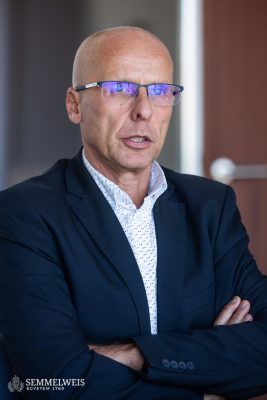 Dr. Tamás Bodzay comes from a third generation family of doctors on his mother’s side, with several family members having worked in academia. Born in Pécs, he moved to Nyíregyháza with his family when he was four years old. He studied at the nearest medical school, the University of Debrecen, where he was interested in traumatology from the very beginning. This is one of the most stressful areas of patient care, as you have to make quick and important decisions instantly – and that’s what attracted him to it. “As a medical student in Debrecen, I studied trauma care at the Orthopaedic Clinic, and as a white coat student I initially only did plaster casts and suturing wounds, but because I was persistent enough, after a while I was allowed to go into the operating theatres, first as an observer, and later I started assisting. I was fascinated by trauma care, and by my third year there was no doubt that this is what I want to do in the future. I was so committed that even though my grandfather, a pathologist, tried to talk me out of it, but I was adamant and to this day I do not regret my choice,” he recalls.
Dr. Tamás Bodzay comes from a third generation family of doctors on his mother’s side, with several family members having worked in academia. Born in Pécs, he moved to Nyíregyháza with his family when he was four years old. He studied at the nearest medical school, the University of Debrecen, where he was interested in traumatology from the very beginning. This is one of the most stressful areas of patient care, as you have to make quick and important decisions instantly – and that’s what attracted him to it. “As a medical student in Debrecen, I studied trauma care at the Orthopaedic Clinic, and as a white coat student I initially only did plaster casts and suturing wounds, but because I was persistent enough, after a while I was allowed to go into the operating theatres, first as an observer, and later I started assisting. I was fascinated by trauma care, and by my third year there was no doubt that this is what I want to do in the future. I was so committed that even though my grandfather, a pathologist, tried to talk me out of it, but I was adamant and to this day I do not regret my choice,” he recalls.
Dr. Tamás Bodzay started working at the then National Institute of Traumatology in 1988.
Since my early career, I was more attracted to the care of the severely injured with life-threatening conditions than to the tertiary priority of performing function-saving limb surgery. Of course, I have mastered such techniques and still practice them today, but it is still the care of the severely injured that is closest to my heart.
– he said. He added that this has given him the opportunity to gain experience in the treatment of body cavity injuries, and that his main speciality is the surgical treatment of pelvic ring and hip joint injuries. He wrote and defended his doctoral thesis on this topic at Semmelweis University. After the merger of the Department of Traumatology and the casualty ward at the Péterfy Sándor Street Hospital with the National Institute of Traumatology in 2007, he continued to teach as a visiting lecturer in Hungarian, English and German. Later, at the request of his departmental predecessor, Dr. György László Hangody, he gave lectures on his specialties.
He is also closely involved in education through postgraduate training. “In Hungary, to qualify in orthopaedic traumatology, you need to pass two international licensing exams – those diplomas are accepted anywhere in the world because they are backed by knowledge. There are four countries in Europe where both courses are mandatory for trauma care, and as a board member and future president of the Hungarian Traumatology Society, I am particularly proud that the training of specialists in our country is of such a high standard,” he underlined. As the representative of the Hungarian Traumatology Society, he organized the Budapest training site of the so-called ATL course, which teaches the first few hours of the protocol concerning the hospital care of the seriously injured, while as the president of the Hungarian organization of the training system, which was formed from the German medical group AO (Arbeitsgemeinschaft für Osteosynthesefragen), he has been involved in training as an instructor for almost 20 years.
According to the clinic director, to become a good traumatologist, you need to have a very high tolerance for stress and quick decision-making. Physical stamina is also important, as a lot of trauma care takes place at night, which is particularly demanding in terms of work.
“I’ve been running every day for about thirty years, and I’ve completed five marathons. My job requires me to be able to tolerate monotony. In addition to that, the lifestyle of a carer of the disabled requires a reasonably tolerant family background. My wife is the head of the education department at my former workplace, and she herself said more than once that if she didn’t work there, she wouldn’t necessarily understand what we do and how it translates at home,” he underlined.
Dr. Tamás Bodzay has been managing working groups of various sizes at the Dr. Jenő Manninger Traumatology Center in Budapest for almost ten years. “Authenticity and leading by example – these are my main guiding principles as a leader. I consider them particularly important in manual specialties such as traumatology. Think of „The Jungle Book”: Akela is the leader of the pack as long as he can kill the first fawn in the spring,” he pointed out. Traumatology has come a long way in recent decades, he said. In the care of the seriously injured, for example, there has been a particular focus on the rapid diagnosis of patients with coagulation disorders – targeted therapy tailored to the specific blood disorder and patient has significantly reduced the number of deaths from haemorrhage. Over the last ten to fifteen years, osteosynthesis techniques have become ubiquitous, with the introduction of angle-locked screw plate systems, which provide a significantly stronger fixation of a fractured bone for healing. But equally revolutionary changes have taken place in shoulder surgery, arthroscopic surgery, knee surgery, virtually all musculoskeletal surgery. “Medicine is constantly evolving, and the life plan of a doctor, and therefore of a traumatologist, is lifelong learning,” he stressed.
Ádám Szabó
Translation: Viktória Kiss
Photo: Bálint Barta, Attila Kovács – Semmelweis University
